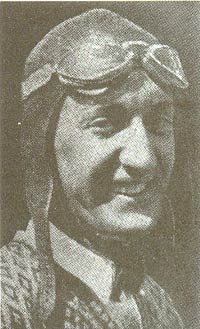|
BARNSTORMER, RACER, TEST PILOT, TRANSPORT PILOT
James Shelly Charles was born in Winston-Salem, NC on August
1, 1900. He learned to fly in 1920 with the U.S. Army at
March Field, Riverside, CA. He held an Army commission as
Lieutenant in the reserves.
He later barnstormed as a stunt
flyer with Mabel
Cody's Flying Circus. He tired of the nomadic
barnstormer's life and sold airplanes throughout the Middle
Atlantic States during the boom days of 1927-29. He participated
in two transcontinental air races (3rd place winner in the
Class B NY to Spokane race in 1927) and became a member of
the Caterpillar Club (see below).
After the Great Depression started, he established a flying
school at Charles Field, Richmond, VA. He joined Eastern
Air Transport on December 1, 1930 as pilot on the Richmond-Atlanta
run.
Charles landed twice at Tucson, both times flying Alexander
Eaglerock NC7185. Based at Richmond, VA, he was a competitor in the National Air Races of 1927 (placed 3rd in the New York to Spokane Class "B" race, winning $1,000 for his effort) and 1928 (he placed 6th in the New York to Los Angeles Class "A" race, winning $300).
It is during this second race we find him at Tucson. In his landing
on September 9, 1928 he was westbound from Lordsburg,
NM to Los
Angeles, CA. His second landing was on September 20, 1928, eastbound
from Los Angeles to El Paso, TX.
In 1928, he also participated
in the closed course civilian relay race with the five-man
"White Team", captained by Jack
Frye, with Paul Richter as
a fellow team mate. The White team placed first in the 40
mile circuit and won $1,500.
His
Eaglerock airplane was an A-2 model, C/N 598, with OX-5 engine. Charles
was the distributor for Alexander Eaglerock aircraft in Virginia.
Alexander aircraft were made in Colorado Springs, CO.
About a year after he landed at Tucson, on Monday October
7, 1929, Charles was at the Alexander factory hired to test
fly what had become known as the "Killer Bullet", a newly designed,
low-wing aircraft that had a fondness for not recovering
from test spins. It had killed a couple of test pilots.
Charles was the third pilot to test the Alexander "Killer
Bullet". At 14,000 feet above sea level (about 8,000 feet
above the ground at Colorado Springs), he throttled back
the Wright J6-5 engine of the Bullet. He pulled the stick
back and held hard right rudder. The airplane made five normal
spins, then, according to Charles, "went flat".
J.S. Charles, Popular Aviation, July, 1934 (Source: PA)
 |
As he fought the controls, the airplane lost 5,000 feet
of altitude. Then, according to a preconceived plan, he broke
through the emergency hatch, crawled out on the left wing
and was catapulted away from the airplane. He landed close
to the airplane, keeping his parachute rip-cord handle to
prove his membership in the Caterpillar
Club. He earned $500 for that flight. The next test pilot
demanded, and got in advance, $1,000 (that one crashed,
too, killing the pilot).
From the Web, Charles developed an airport (with others) ca. 1927 in Richmond, VA. The field was variously called Charles Field, Hermitage Airport, Eaglerock Airport and Richmond Airport. in the early 1930's, then airline pilot Shelly Charles operated an open primary glider from auto-tow at the old Washington-Hoover Airport (where the Pentagon stands today). His flights were usually of short duration before an appreciative Sunday afternoon crowd. A Web link, with photographs, ties him to a glider altitude record in 1943.
My information ends here. If you have any to add, please
contact me here.
---o0o---
From Capt. S.S. McDonald, Eastern Airlines (Ret) on November 1, 2008 comes this information:
"Shelly and his brother P.D. Charles both flew for Eastern. Shell was hired 1 December 1930 with seniority number 21. Shelly died in 1958. P.D. Charles was hired 15 November 1931 with seniority number 32. P.D. Charles died 1994."
Thanks to Capt. McDonald for sharing this with us.
---o0o---
From site visitor Robert Brown on July 27, 2009 comes this information. Note the discrepancy in date of death.
"Capt. James Shelly Charles retired from Eastern Airlines on April 1, 1959. He died of a heart attack on August 22,1959. Both items reported in The Great Silver Fleet News. He also had the distinction of making the last flight of U.S. airmail in an open cockpit biplane in 1935."
---o0o---
From the July, 1934 issue of Popular Aviation (PA), right, a brief article about Charles.
Dossier 2.1.71
UPLOADED: 03/20/06 REVISED: 11/03/08, 03/09/09, 07/29/09, 10/04/13, 06/26/14
|



